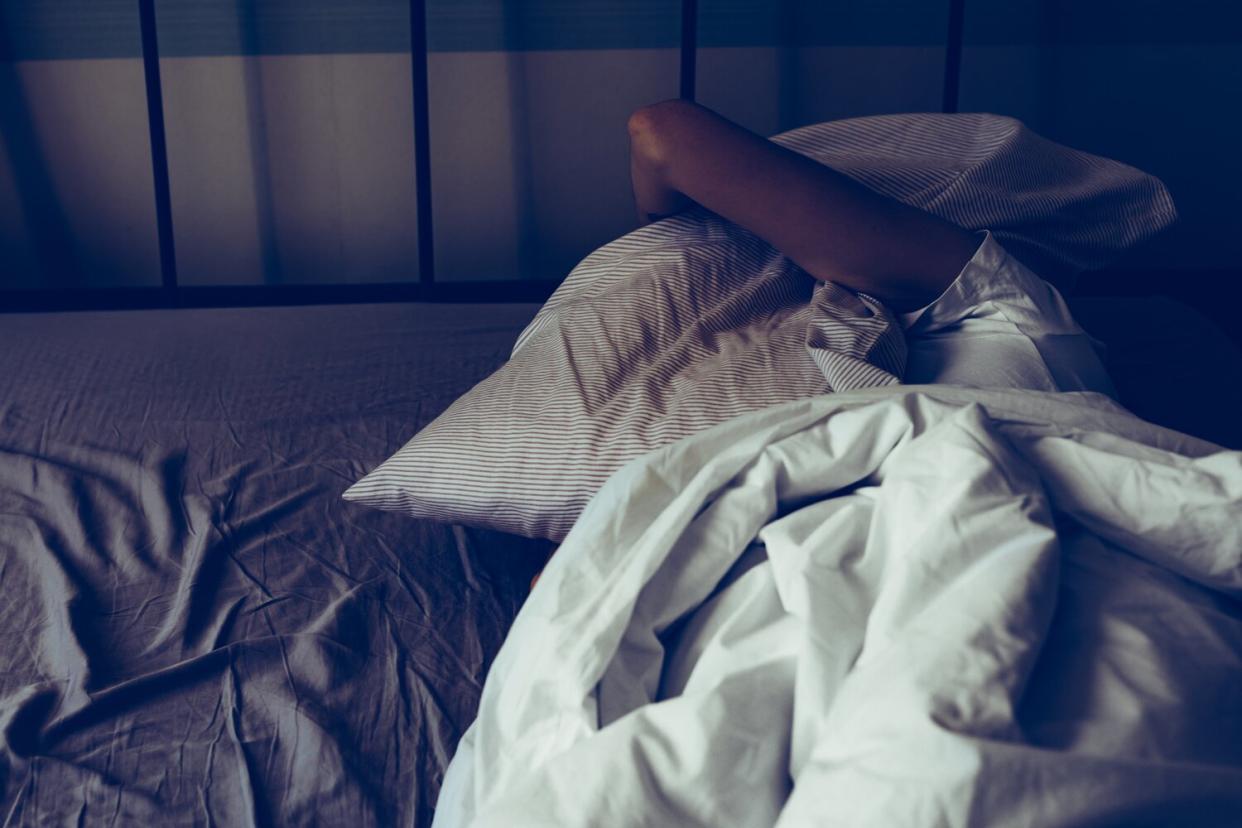The Surprising Signs of Summer Seasonal Affective Disorder

Getty Images
While many are familiar with getting the winter blues, summer is more commonly thought of as a season of relaxation and happiness. For many, however, depression and anxiety can be a part of the warm months, because of a condition called Seasonal Affective Disorder, or S.A.D.
What is Seasonal Affective Disorder?
If you've heard of S.A.D before, it was probably described as a condition exclusive to fall and winter. The reason, according to neuro-psychologist Dr. Sanam Hafeez, PsyD. (who is also an expert for LOUM Beauty), is "a correlation between lack of sunlight and the neurotransmitters that regulate depression and circadian rhythm." In other words, lack of sunlight can not only decrease vitamin D levels but dysregulate serotonin, the neurotransmitter directly responsible for balancing mood.
Those with S.A.D also tend to overproduce melatonin, the hormone that causes sleepiness, though it's rarely a sole cause or symptom. Additionally, Seasonal Affective Disorder can manifest at varying levels, from mild to severe, depending on the unique circumstances of the person experiencing it.
Who does it impact most?
Experts have noted some trends that correlate with incidences of Seasonal Affective Disorder. People who live further from the equator, both north and south, tend to be diagnosed more. Additionally, women are generally diagnosed more than men, though that could simply be because data suggests women make higher use of primary physician care.
To that same point, gender disparities still vary according to different conditions. In recent years, medical gaslighting and gender bias has also been highlighted as a major roadblock to proper and accurate treatment for women. In short, healthcare is impacted by many factors, but generally speaking, depression doesn't discriminate and can affect people from all walks of life.

Getty Images
S.A.D in the summer
Given the correlation between sunlight and S.A.D., what causes it to affect people into the summer as well? There are a couple of reasons. Sometimes, it's simply the hangover of winter S.A.D.
"Though we typically think of it as a winter problem, it can certainly happen year-round," says psychotherapist and brain health expert Dr. Teralyn Sell. "This could be particularly true in the summer, as our winter batteries have not been recharged and we head into summer on a low vitamin D tank expecting for the sun to do all the heavy lifting." (It's worth noting that getting too much sun can be just as impactful as not getting enough, as overexposure can lead to heat exhaustion and other physical conditions with negative emotional side effects.)
The activities we choose to do or not do can also precipitate depression. According to a Springer Link study on how activity and weather impact seasonal and non-seasonal depression, activity level and enjoyment tends to be low in inclement weather, and those aren't season-specific. For example, both a snowstorm and an especially humid day could be reasons to stay inside; when done repeatedly, will deprive the body of natural sunlight, and eventually, healthy serotonin levels.
"This tells us that we have more control over our depressive symptoms than blaming it on the weather alone. What we choose to do in inclement weather is more important than the weather itself," explains Dr. Sell. (Translation: Try to get outside, even when it's not that appealing.)
Of course, experts say, there's an additional (and obvious) stressor for many: an ongoing pandemic that continues to test our capacity for grief and affect our daily lives.
"Some of the stand-out mental health challenges that I have seen grow out of the pandemic are anxiety, depression, re-activation of trauma, and addiction issues," says Dr. Hafeez. "Pandemic isolation caused depressive symptoms. The pandemic itself reactivated hypervigilant trauma responses where the whole world was a threat. This threat also kicked in fight or flight, creating anxiety for many."
She also adds that the types of stressors have changedover time: "In general, many people were initially overwhelmed and stressed out during the immediate changes of the pandemic, like working from home. Then, another wave of stress, the return to the office, which caused another round of panic."
Keep reading for a quick rundown of the most common symptoms of Seasonal Affective Disorder and ways to combat them.

Getty Images
Symptoms:
Irritability
Because crabbiness is a common symptom of generalized depression, it's easy to overlook this as a culprit of S.A.D. Don't write off unhappiness or negativity, especially if the cause feels abstract or difficult to identify. Ever find yourself easily crying at movies or commercials in a way you haven't before? An increased intensity in emotions could also signal imbalanced serotonin levels.
Lack of Motivation
Struggling to stay present with friends and family? Do you feel low on energy, even with a proper night's sleep? If starting and/or finishing even the smallest task feels like an insurmountable goal, that could also indicate S.A.D.
Difficulty Falling Asleep
Speaking of sleep, not getting enough will do you no favors. But if it's taking you hours to arrive in dreamland (or, conversely, hours to feel awake), Seasonal Affective Disorder may be to blame.
Increased Isolation
When solitude morphs into intense isolation, problems can arise. Spending most of your time alone and avoiding connection with others can exacerbate S.A.D.
Suicidal Ideation
Again, Seasonal Affective Disorder is an individualized condition. Whereas it may impact some mildly and be easily treatable, for others, it could lead to the most severe symptoms, including suicidal ideation. If you or someone you know is considering suicide, please contact the National Suicide Prevention Lifeline at 1-800-273-TALK (8255), text "STRENGTH" to the Crisis Text Line at 741-741 or go to suicidepreventionlifeline.org.

Getty Images
How to Treat Seasonal Affective Disorder
Treatment will depend on factors unique to you, including lifestyle choices and accessibility, but there are a couple of topline remedies all of us can take advantage of.
Get Organized
Dr. Hafeez recommends planning ahead. "Prepare in advance, such as planning activities and events in the winter months," she says. This is especially important for activities with family and friends, as it will keep you accountable and make it easier to accept help from others when you need it. To that same point, make the most of your alone time with meditation and journaling. Both will help increase and maintain a healthy level of self-awareness and organization, thus warding off that all-too-common lack of motivation.

Getty Images
Step Into the Light
Another straightforward solution that also happens to cost nothing: get outside! Dr. Sell says "the rule of thumb is about 30 minutes a day of not only outdoor activity, but as much sunlight soaking as you can." The dangers of excessive UV exposure are real, but so is the need for recharging low vitamin D levels. Apply sunscreen and wear sunglasses if you have sensitive eyes, but be sure to get a healthy amount of sunshine daily.
For days when getting outside is a challenge, a S.A.D. lamp can mimic the benefits of natural sunlight. Go for a 10,000 lux lamp, and use it for 30 minutes a day, preferably in the morning and especially during inclement weather.
Mind Your Eating Habits
Eating fruits and vegetables never goes out of style, and it's more important than ever when you're living with Seasonal Affective Disorder.
"Pay attention to eating nutrient-dense foods, including whole fruits and vegetables, protein and healthy fats," says Dr. Sell. "Basically, eat more plants, protein and fish. Nutrition fuels our neurotransmitters (serotonin, dopamine) and will help to improve your mood. This is useful year-round."

Getty Images
Know Your Vitamin D Levels
When S.A.D. is suspected, the go-to move for many is to simply take a vitamin D supplement and hope it's a magic bullet cure. The smarter move is to first make an appointment with your primary care physician, who can check your vitamin D levels once in the fall and once in the spring.
According to Dr. Sell, "this will allow you to understand your vitamin D patterns and whether or not you need to optimize your D levels through supplementation." You may find that your vitamin D levels are just fine, and that you need help in other areas that are medical- and/or lifestyle-based.
Seek Therapy
Talking to a mental health professional offers many benefits, including connection, accountability, safety, and possibly medication if deemed necessary. It can also provide the tools for longterm healthy living, among other things.
It's become apparent that therapy is not always accessible option for everyone. In underserved communities, low-income groups and among people of color, access to affordable mental health care, and affordable healthcare in general, remains a hurdle. Today, mental health apps, non-profit clinics with sliding scale fees, and mental health awareness initiatives are helping to fill the gap.
Telehealth therapy, or therapy that can be done wherever you have Internet access, has also been popularized, even more so during the pandemic when social distancing rules required it. Ultimately, seeking help starts with focusing on what you can control.
"We don't always need professional help," says Dr. Sell. "Sometimes, we need to just incorporate more brain nourishing activities and foods into our day. However, if you already live a healthy lifestyle and can't shake those blues," don't hesitate to seek help.

